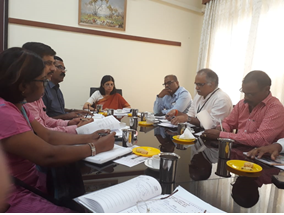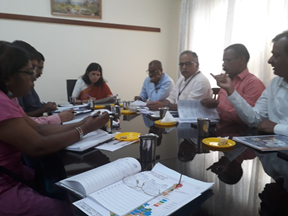State Level Interface Meetings on Enhancing the Preparedness for Agriculture Contingencies during kharif 2019 for Karnataka and Gujarat were organized at Bengaluru and Ahmedabad on 19th and 21st June, 2019, respectively.
Karnataka
The state level meeting for Karnataka organized at Vidhan Sabha was chaired by Ms. Vandita Sharma, I.A.S., Additional Chief Secretary and Development Commissioner.
Dr. S. Bhaskar, ADG (AFCC), ICAR; Dr. K.V. Rao, ICAR-CRIDA; Dr. G. Srinivas Reddy, Director, KSNDMC and representatives from Ministry of Agriculture & Farmers’ Welfare, Government of India and various State Departments attended the programme.


During the meeting, the rainfall forecast for the Kharif - 2019 and month-wise distribution for the state and probable rainfall - 2019 in command and catchment areas of Krishna, Cauvery basin - 2019 were shared with state representatives.
Shri B.Y. Srinivas, Director, Department of Agriculture, Government of Karnataka stated about the impact of deficiency in the rainfall during month of June on the agriculture crops in the state.
While comparing the present season situation with the last year, Ms. Vandita Sharma stressed on the need for the adequate preparedness for meeting the contingency situations, if any. Due to the deficient rains in the catchment areas, the availability of water in reservoirs was found to be less as compared to last year.
Recommendations:
- Encouragement of cultivation of sunflower, maize, etc., in place of black gram and green gram crops as the sowing window is over.
- Suggesting sunflower and maize in place of Sorghum if enough rains are not received in sorghum growing areas before end of month of June.
- Monitoring the progress of sowings weekly basis and initiate steps for implementation of contingency plans, if sufficient rainfall is not received till 15th July.
- Possibility of raising community nurseries for paddy in paddy growing areas.
- Ensuring sufficient seed and fertilizer supply.
- Focus on Northern Karnataka districts for next 2 weeks due to diversity of crops grown in the region.
Gujarat
The State level Interface Meeting for Gujarat organized at New Sachivalay, Ahmedabad was chaired by Shri Sanjay Prasad, I.A.S., Additional Chief Secretary.
The various Senior Officials of Central and State Government Departments marked their presence during the meeting.


The rainfall forecast for the Kharif - 2019 and month-wise distribution for Gujarat were shared with the State representatives. The Information on long dryspells which were observed during last 4 years using sub-district rainfall were also shared and informed that the North Gujarat Districts were impacted long dryspells almost on a yearly basis. Saurashtra was also frequently getting impacted by the long dryspells. The rainfall received during the month of June due to cyclone Vayu were discussed in detail.
Shri B.M. Modi stated about the impact of deficiency in rainfall during the month of June on agriculture crops in the state and particularly in the region of South Gujarat and seed and fertilizer availability. Despite delay in the onset of monsoon so far in the state, farmers had sown in area of about 2.5 lakh hectares, mainly in Saurashtra region, with rains received from cyclone Vayu and in areas with irrigation facilities.
Recommendations
- Identify and suggest alternate remunerative corps for Gujarat state considering high variability in rainfall as long term measure to counter the climate variability
- Encouraging in-situ moisture conservation practices for cotton and pulse crops
- Ensuring the timely sowing of groundnut, cotton and other crops with suitable farm machinery
- Enhancing the area under millets where crops are not sown within the sowing window
- Monitoring the progress of sowings weekly basis and initiate steps for implementation of contingency plans, if sufficient rainfall is not received till 15th July.
(Source: ICAR-Central Research Institute for Dryland Agriculture, NRM Division)







फेसबुक पर लाइक करें
यूट्यूब पर सदस्यता लें
X पर फॉलो करना X
इंस्टाग्राम पर लाइक करें